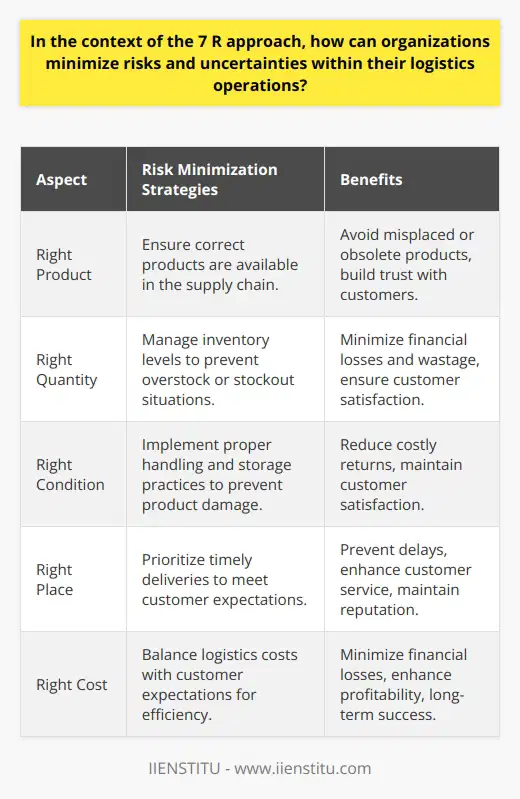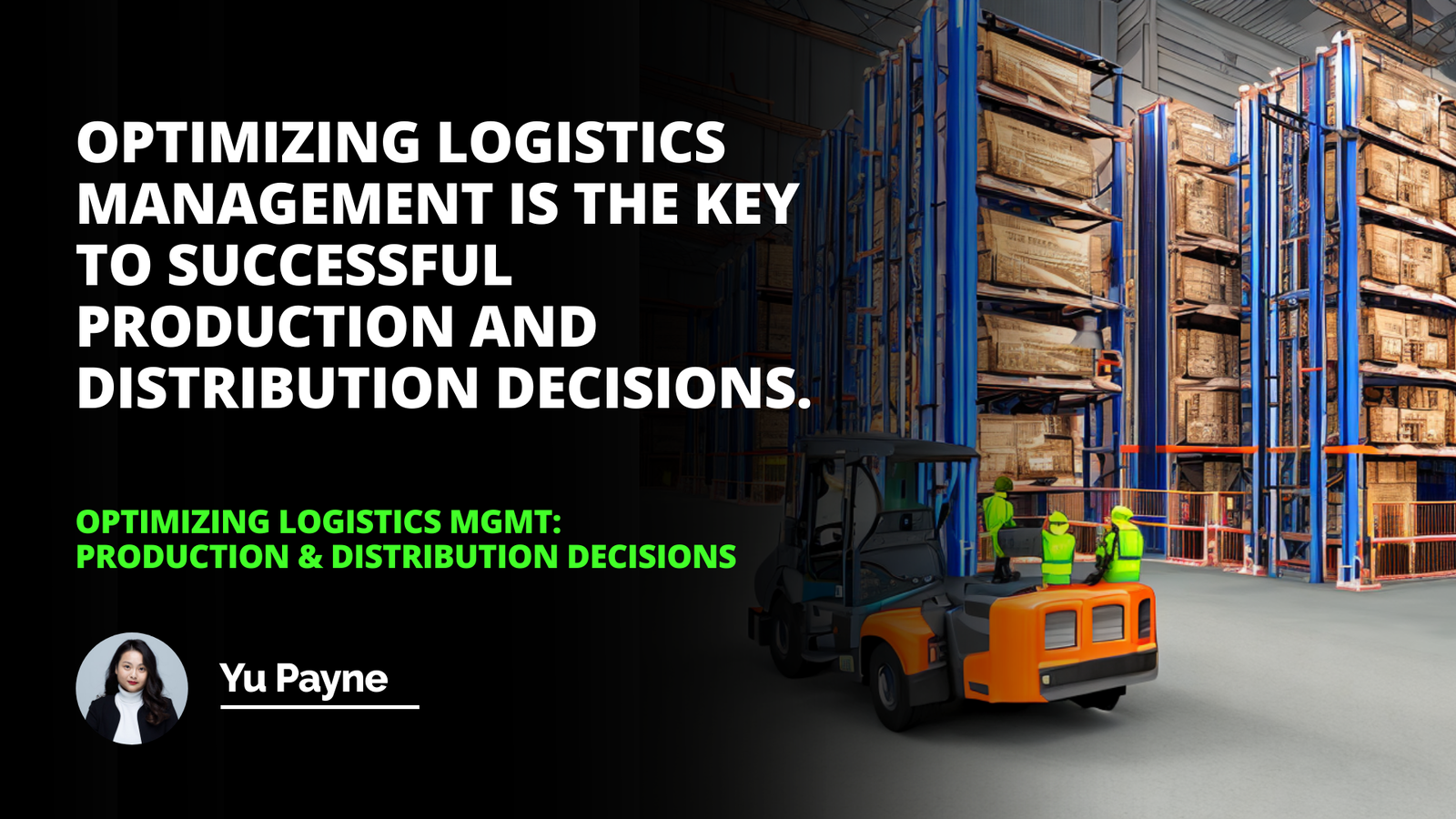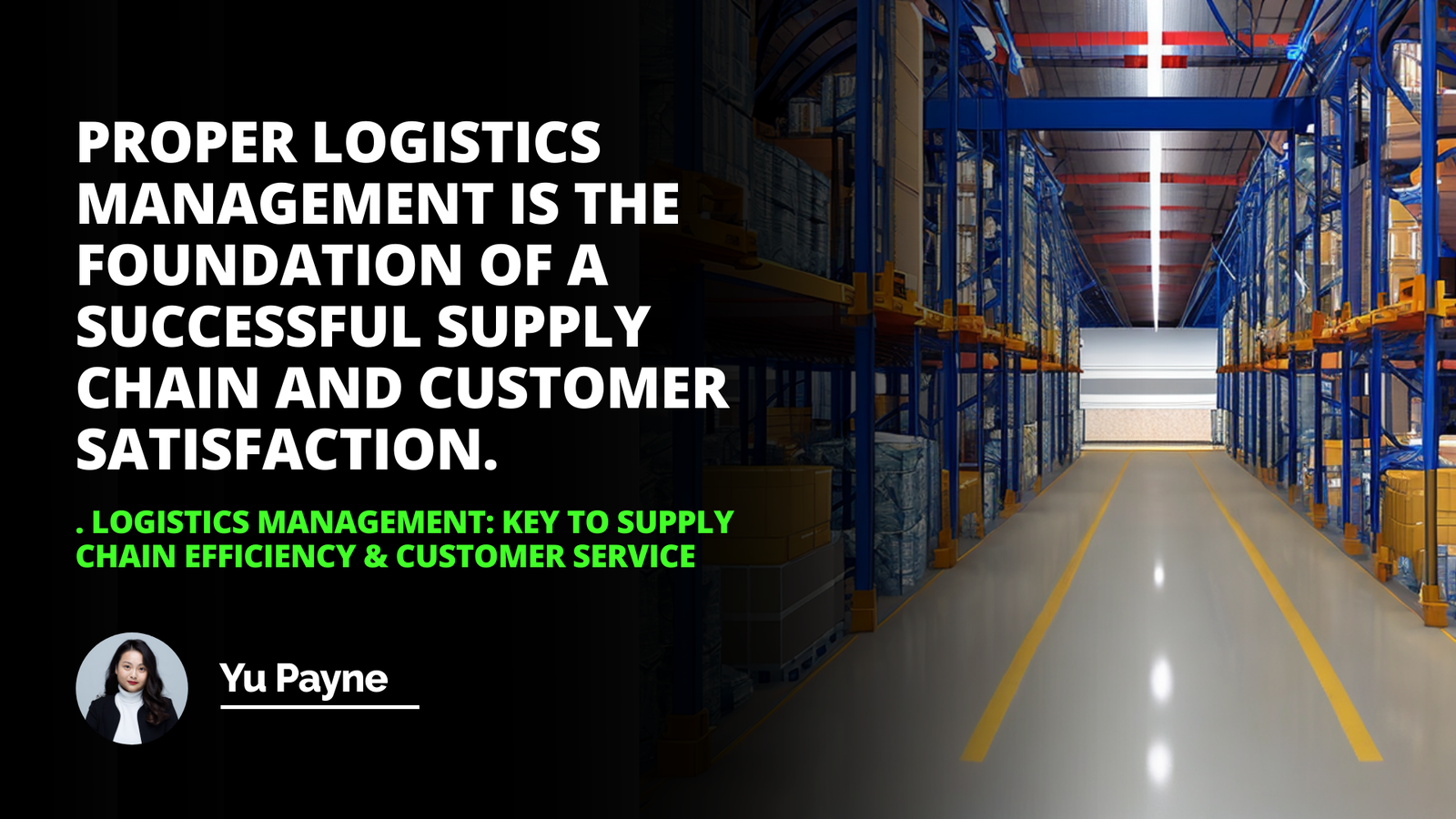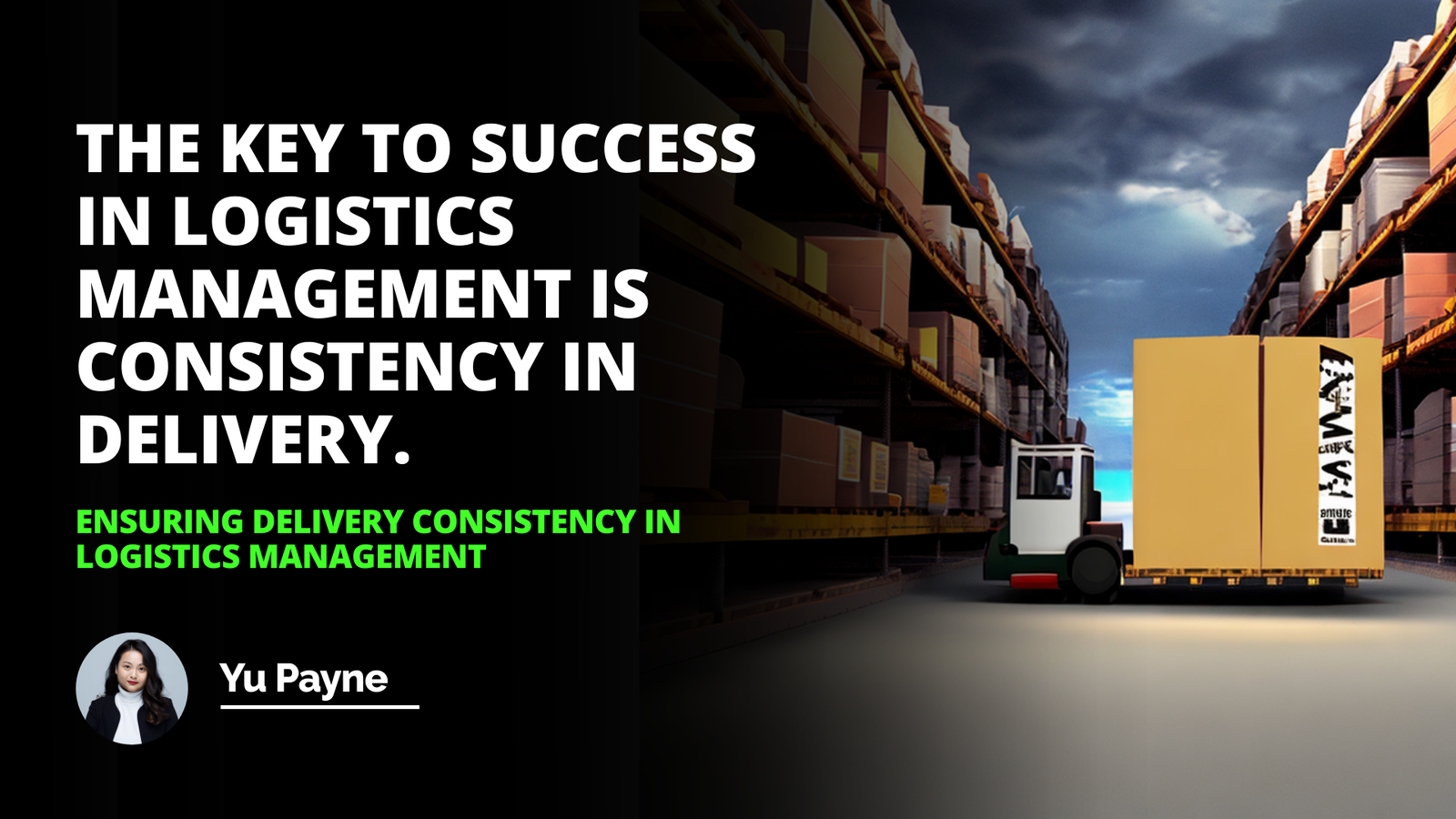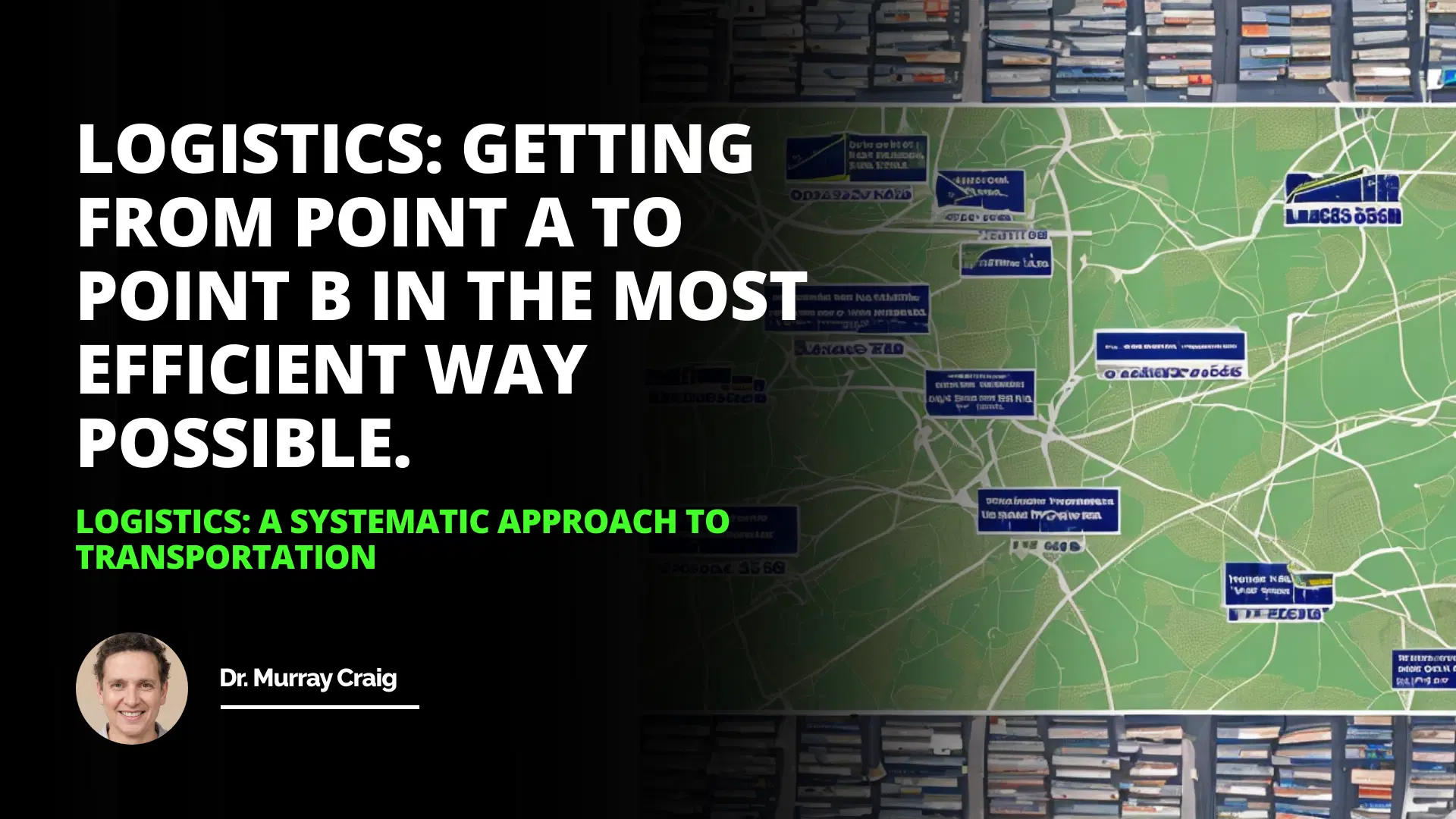
Benefits of Systematic Approach for Transportation
Challenges of Systematic Logistics
Recommendations for Improving Logistics System
Logistics is the process of planning, organizing, and managing the movement of goods and resources from one place to another. It involves the coordination of transportation, Warehousing, and other processes to ensure that products and services reach their destination most efficiently and cost-effectively. Logistics plays a vital role in the economy by making products available to Customers on time and providing essential support services to businesses.
Benefits of Systematic Approach for Transportation
Logistics Systems that are planned organized and managed systematically offer numerous benefits to businesses. The most important advantage of such systems is increased efficiency. Companies can use systematic processes to optimize their transportation system to reduce delays and minimize unproductive activities. These systems also reduce the risk of accidents and errors, improving safety. Additionally, systematic logistics systems help companies reduce the cost of transportation by streamlining processes and cutting the costs of packing, loading, and unloading.
Challenges of Systematic Logistics
Despite their numerous benefits, systematic logistics systems are often associated with challenges. The most significant challenge is the coordination of movements. Coordinating the different elements of a logistics system (such as transportation, warehousing, personnel, etc.) can be difficult and time-consuming. Additionally, the complexity of these systems can often be expensive, as companies must invest in sophisticated software and hardware to manage them properly. Moreover, companies must comply with relevant legislation and regulations, further complicating logistics. Systematic logistics systems can provide numerous advantages to businesses by increasing efficiency, improving safety, and reducing costs. However, these systems also come with specific challenges, such as coordination of movements, cost of complexity, and compliance with regulations. Ultimately, businesses must weigh the pros and cons of systematized logistics and decide whether the benefits outweigh the drawbacks.
Recommendations for Improving Logistics System
Businesses can make use of several strategies to improve their logistics systems. First, they can invest in the latest technologies, such as advanced software and hardware, to manage better and monitor the movement of goods and resources. Secondly, they should streamline their processes to ensure that they remain cost-effective. Lastly, they should ensure their systems comply with relevant legislation and regulations.
Logistics Getting from point A to point B in the most efficient way possible.
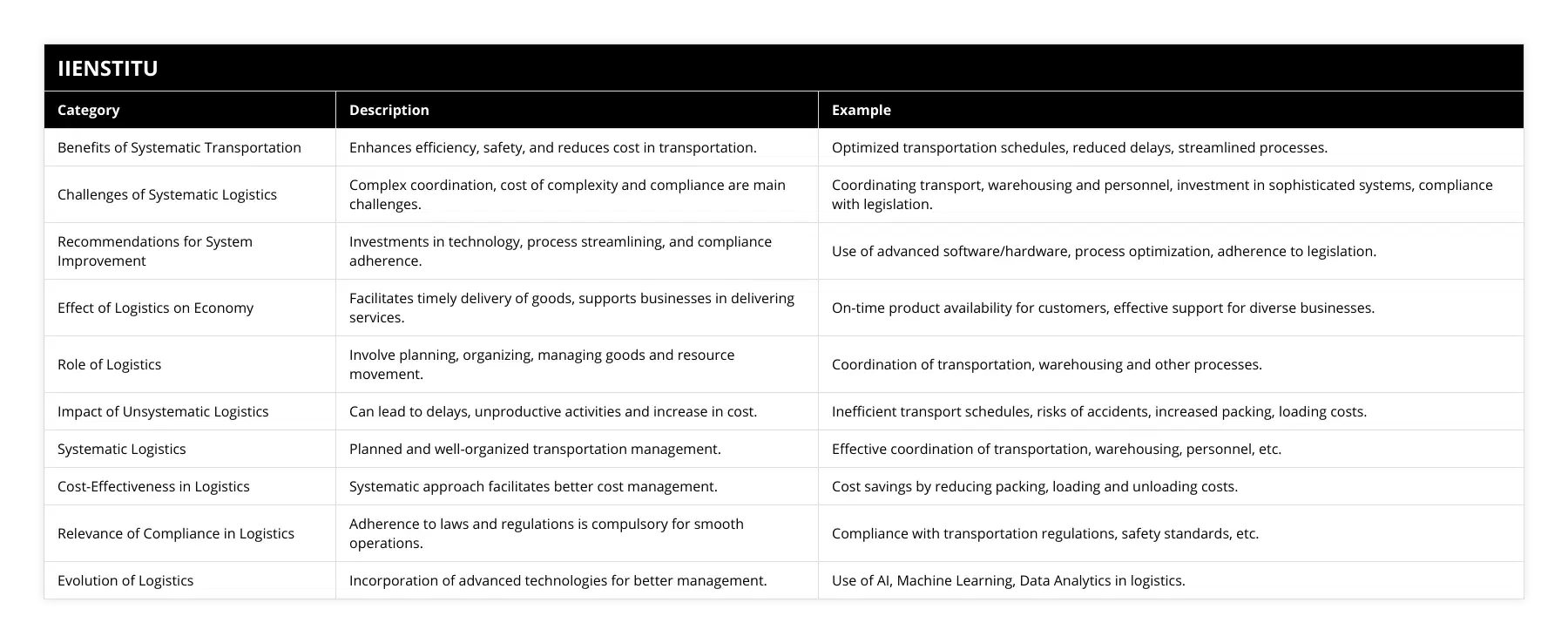
Frequently Asked Questions
What are the different types of transportation methods utilized in logistics systems?
Logistics systems are a vital component of modern industry and commerce. With economic globalization, supply chain networks have become increasingly complex. Looking for solutions to ensure the efficient and timely movement of goods from one point to another has become a significant focus of recent research. Transportation forms an essential part of any logistics system, and there are a variety of different transportation methods which may be utilized.
Regarding passenger transportation, ground-based methods such as automobiles, coaches, and trains are preferred for short-distance commutes. However, airplanes are used for longer distances and are a cost-effective and rapid mode of transport. For longer journeys, for example, over oceans, shipping is the most common option.
When it comes to freight transport, the primary choice is airfreight. This is used for international distribution as it is faster and more reliable than other methods. However, long-distance overland freight transportation relies heavily on trucks due to their large carrying capacity and ability to navigate challenging roads, especially in areas without rail infrastructure. Rails can also carry bulky cargo consignments and are especially suitable for short journeys.
Finally, intermodal transport — a combination of land, sea, and air modes of transportation — may also be utilized for freight transportation. This method allows for the efficient and cost-effective transport of goods from one location to another. It may include transferring containers from one form of transport to another, such as from ship to truck.
In summary, the most suitable transportation method depends on the cargo size, the journey's distance, and the delivery's urgency. Still, whatever the circumstances, there is likely to be a suitable transportation method available. Many of these methods are paramount to the efficient functioning of modern supply chains and, as such, must be carefully planned and managed to ensure fast, consistent, and cost-effective deliveries.
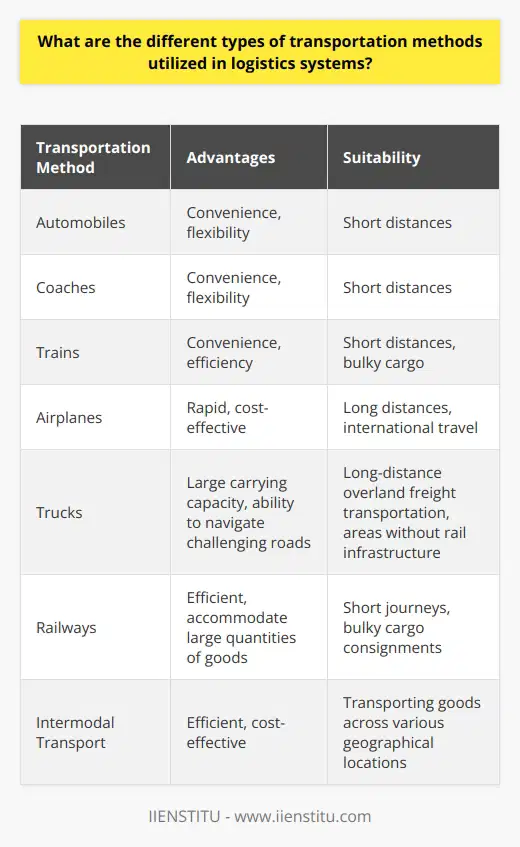
How can data analytics improve logistics processes?
Data analytics can bring many transformative changes to the logistics industry. This article will explore how data analytics can streamline processes within a logistics environment and how it might be possible to benefit from cost savings and improved efficiency.
Logistics represents an incredibly complex area of operations. From transportation to inventory management to storing goods, the complexity of logistics processes means that it is often difficult to optimize resources. However, with the development of data analytics technology, it is possible to gain deeper insights into the real-time performance of any given logistics system. This allows for more informed decisions with greater accuracy, reducing waste, inefficiencies, and costs.
Data analytics can track and evaluate key performance indicators (KPIs) such as on-time delivery, cost per shipment, and average turnaround times to provide a comprehensive performance overview. This data can then identify and analyze trends, enabling businesses to make data-driven decisions promptly.
By leveraging data analytics, it is also possible to build predictive models to help anticipate future demand. This can be used to better match supply with demand and optimize the allocation of resources. Furthermore, data analytics can identify bottlenecks within the system, allowing for timely solutions to be implemented.
Data analytics can also be applied to optimize routes, ensuring that the most efficient way is chosen and that the required resources are allocated accordingly. Additionally, data analytics can identify areas where processes can be streamlined, allowing for cost savings.
Data analytics can be compelling in the logistics industry. By using this technology to track and analyze KPIs, build predictive models, optimize routes, and identify areas for process streamlining, businesses can be sure that their logistics environment is running as efficiently and cost-effectively as possible.
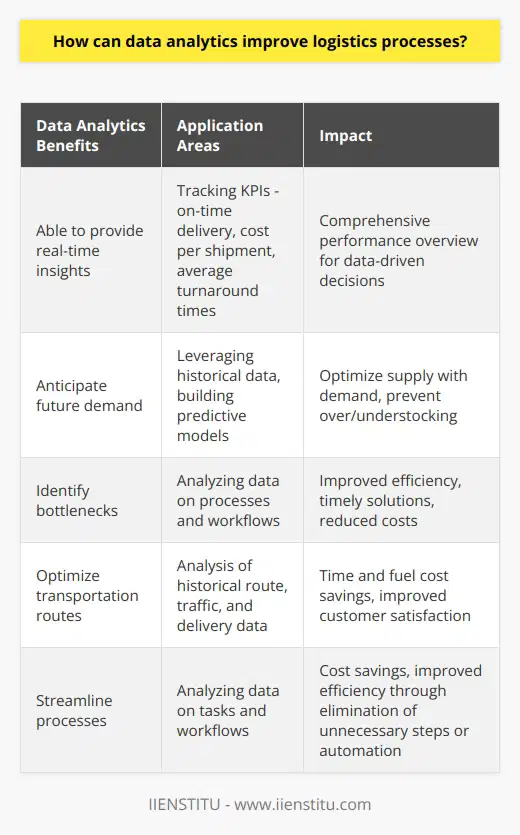
What are the most effective methods of improving supply chain management?
Supply chain management (SCM) is essential to any organization’s operations, from production to delivery. As such, companies must use a range of efficient and effective SCM tools and processes to ensure maximum profitability and productivity. Several methods can be used to improve supply chain management through technological advancements and better management strategies. This article will discuss the most effective approaches in detail.
One of the most efficient ways to improve supply chain management is to adopt a holistic approach, which considers all aspects of the process. This includes looking at the totality of supply chain activities, including demand forecasting, inventory management, purchasing, transportation, and other related activities such as quality assurance and customer service. By taking a comprehensive view of SCM operations, companies can understand the bottlenecks or inefficiencies and devise solutions to address them.
Using innovative technologies is another critical way to improve supply chain management. For example, automation, data exchanges and analytics, predictive technologies, and artificial intelligence (AI) can all be employed to streamline the process and ensure a more efficient outcome. In addition, by improving visibility across the supply chain, companies can identify and address problems before they become issues and make operations more efficient.
Moreover, better collaboration between buyers and suppliers is another meaningful way of improving supply chain management. By establishing trusting relationships with suppliers, companies can build strong working relationships that benefit both parties, making forecasting demand and planning easier. In addition, open communication between buyers and suppliers can spearhead continuous improvement initiatives and positively impact cost savings, lead times, and inventory management.
In conclusion, there are several ways to improve supply chain management. First, companies should consider adopting a holistic approach that looks at all process aspects, incorporating new technologies, and promoting better collaboration between buyers and suppliers. Taking advantage of these methods is essential for any organization to succeed in this highly competitive environment.
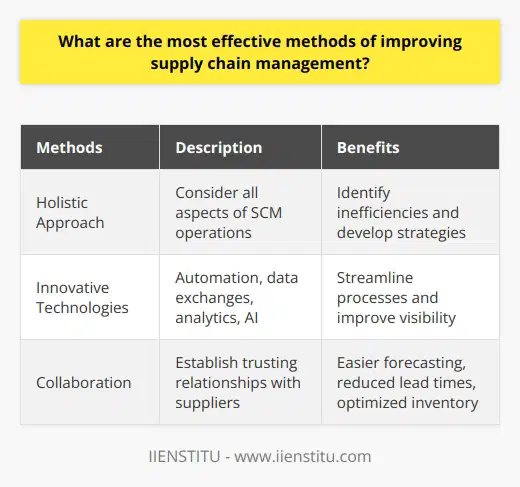
What is the systematic approach in logistics?
Systematic Approach in Logistics: Definition
The systematic approach in logistics refers to the structured and methodical process employed in managing the flow of goods, information, and resources from the point of origin to the point of consumption. This approach emphasizes the importance of coordination, organization, and optimization in order to achieve efficient and effective supply chain operations. By utilizing a systematic approach, companies can minimize costs, reduce lead times, and improve customer satisfaction.
Key Components of Systematic Approach
Planning and Strategy
The foundation of a systematic approach in logistics lies in developing a solid plan and strategy. This involves understanding the business objectives, assessing the market environment and customer needs, determining the best distribution channels, and identifying the right transportation resources.
Integration and Collaboration
An effective systematic approach emphasizes seamless integration and collaboration among all supply chain partners. This includes sharing critical information among stakeholders, coordinating activities, and working together to solve problems, ensuring a smooth and efficient flow of operations.
Technology and Automation
Utilizing the latest technology and automation tools is another essential aspect of a systematic approach in logistics. This includes employing sophisticated software systems to track and manage inventory, utilizing advanced transportation management systems, and leveraging data analytics for forecasting and demand planning.
Performance Measurement and Continuous Improvement
An integral part of the systematic approach is to consistently measure performance and identify areas for improvement. Companies should establish key performance indicators (KPIs) to monitor supply chain performance and use these metrics to make data-driven decisions geared towards continuous improvement.
Risk Management and Contingency Planning
Implementing a systematic approach in logistics also entails preparing for potential risks and disruptions. Organizations should identify potential vulnerabilities in their supply chain, develop contingency plans, and establish robust risk mitigation strategies to ensure resilience and business continuity.
Benefits of a Systematic Approach in Logistics
Implementing a systematic approach in logistics offers numerous benefits, such as:
Cost Efficiency: By optimizing processes and minimizing inefficiencies, companies can significantly reduce logistics-related costs.
Improved Customer Satisfaction: Ensuring a seamless flow of goods ultimately leads to higher levels of customer satisfaction and stronger brand loyalty.
Enhanced Flexibility: A well-structured logistics system enables organizations to respond quickly to market changes and customer demands, providing a competitive advantage in the marketplace.
Increased Sustainability: Employing a systematic approach promotes sustainable practices by reducing waste, minimizing resource usage, and lowering the overall environmental footprint of logistics operations.
In conclusion, the systematic approach in logistics is crucial for achieving efficient and effective supply chain management. By emphasizing coordination, optimization, and continuous improvement, companies can greatly enhance their operational performance while reducing costs, meeting customer demands, and ensuring long-term success.

What are the approaches of logistics?
Approaches to Logistics
There are various approaches to managing and organizing logistics within companies and supply chains, each with its own focus and methodologies.
Lean Logistics
Lean logistics is based on the principles of lean manufacturing, which aims to reduce waste, maximize efficiency, and utilize resources effectively. This approach promotes the removal of non-value-added activities and emphasizes continuous improvement within the supply chain. By doing so, lean logistics enables companies to lower the cost, streamline operations, and increase customer satisfaction.
Agile Logistics
Agile logistics focuses on flexibility and responsiveness, as it emphasizes the importance of quickly adapting to changes in consumer demand, market conditions, or other unforeseen disruptions. This approach employs systems and practices that enable real-time data sharing and decision making, such as advanced analytics and technology solutions. Agile logistics facilitates the creation of more resilient supply chains by enhancing the ability to respond effectively to changing circumstances and reducing lead times.
Green Logistics
Green logistics adopts a sustainable approach to managing the entire lifecycle of products and services, from the procurement of raw materials to the final disposal of goods. It seeks to minimize environmental impacts through waste reduction, energy efficiency, and the use of eco-friendly transportation modes. Companies employing green logistics look for ways to reduce their carbon footprint, make operations more energy-efficient, and promote environmental sustainability throughout their supply chain.
Reverse Logistics
Reverse logistics is an approach that deals with the process of managing the return of products, packaging, and materials from customers or other sources. This can involve the collection, transportation, storage, and reprocessing or disposal of returned goods. Reverse logistics is essential for businesses where product returns, repairs, and recycling are a significant part of their operations, such as electronics or automotive industries. By managing this process effectively, companies can not only improve customer satisfaction but also reduce costs and waste associated with returned goods.
Integrated Logistics
Integrated logistics is an approach that involves the collaboration and coordination of all logistics activities and processes within a company or across different organizations in a supply chain. This holistic approach seeks to break down silos and promote effective communication, coordination, and decision-making among different logistics functions, such as procurement, warehousing, distribution, and transportation. The objective is to optimize the end-to-end logistics process to achieve cost savings, enhance service levels, and drive overall supply chain efficiency.
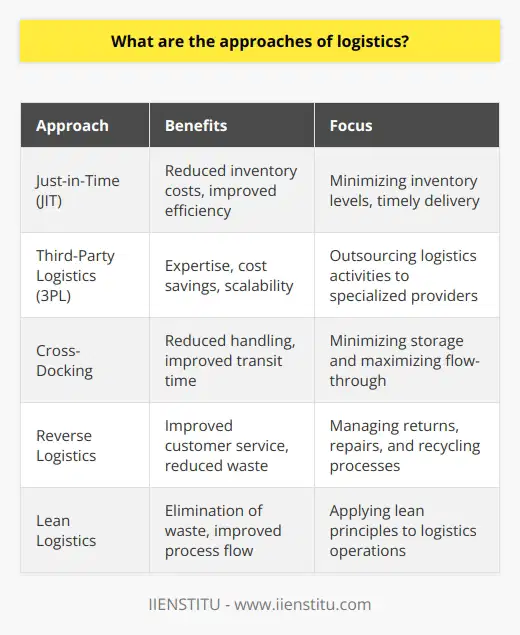
What are the 3 main activities that logistics systems are made up of?
Three Key Activities in Logistics Systems
Logistics Management Activities
Logistics systems strive to ensure the smooth flow of goods and services from the point of origin to their destination. They comprise three main activities – transportation, warehousing, and inventory management – designed to optimize productivity, minimize costs, and meet customer requirements.
Transportation
Transportation is a crucial activity in logistics systems, entailing the movement of goods and services from one location to another. The transportation process employs various modes, such as air, water, rail, and road, each with distinct advantages and limitations. Choosing the most suitable transportation mode depends on factors including the product's nature, required delivery time, and transportation costs. Efficient transportation requires diligent route planning, reliable carriers, and real-time tracking to ensure the timely and safe delivery of goods.
Warehousing
Warehousing plays a critical role in managing product storage, allowing businesses to maintain an adequate supply of goods while mitigating fluctuations in demand. Proper warehousing involves the strategic location of storage facilities to minimize transportation costs, the implementation of effective storage techniques (such as first-in, first-out or just-in-time), and the use of modern technology, like warehouse management systems, to streamline storage management. Warehousing also encompasses various value-added services like product assembly, labeling, packaging, and repackaging to meet customer specifications.
Inventory Management
Inventory management, the third primary activity in a logistics system, is responsible for maintaining appropriate stock levels and ensuring the availability of goods to meet consumer demand. Balancing inventory levels is a complex task, as excessive stock can lead to increased holding costs and obsolescence, while inadequate stock can result in stockouts and lost sales opportunities. To maintain optimal inventory levels, companies employ various techniques, such as demand forecasting, stock monitoring, and inventory control procedures (like ABC analysis). Efficient inventory management improves order fulfillment rates, customer satisfaction, and overall organizational competitiveness.
In conclusion, logistics systems are composed of three essential activities – transportation, warehousing, and inventory management – which, when efficiently executed, lead to cost reduction, enhanced customer satisfaction, and a competitive edge for businesses. By understanding and effectively managing these activities, companies can achieve success in the dynamic and ever-evolving world of logistics.
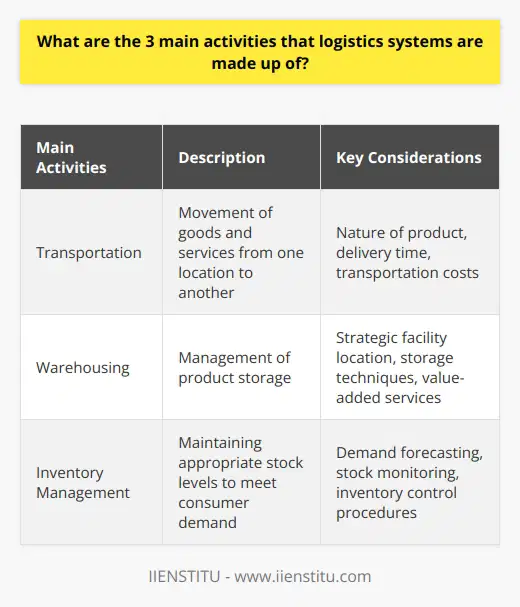
What is the logistics process of transportation?
Logistics Process in Transportation
The logistics process of transportation refers to the systematic coordination of all activities involved in transporting products or materials from the point of origin to the point of consumption. The transportation logistics process includes various stages and components, all of which are critical for ensuring the efficient and cost-effective movement of goods.
Identification of Transportation Needs
A crucial step in the logistics process is identifying the specific transportation needs of a product or material. This involves analyzing factors such as the type and quantity of materials, destination, required delivery time, and available resources. Based on this analysis, the most appropriate mode of transportation can be selected to meet the required needs.
Selection of Transportation Mode
After identifying the transportation needs, the next step is selecting the most suitable mode of transportation. This may involve choosing between air, sea, rail, or road transport, depending on the type of goods, distance, time constraints, and budget. Each mode of transport has its own advantages and disadvantages. Therefore, selecting the appropriate mode is vital for efficient movement of goods.
Planning and Routing
Once the mode of transportation is selected, the next step is to plan and route the movement of goods. This includes identifying the most efficient and cost-effective routes, taking into consideration factors such as distance, fuel costs, traffic, and infrastructure. Proper planning and routing ensure that goods are delivered in the shortest possible time while minimizing transportation costs.
Coordination and Execution
Effective coordination and execution involve managing various activities such as loading, unloading, customs clearance, and documentation. These tasks require the coordination of multiple stakeholders, including suppliers, transportation providers, and regulatory authorities. Ensuring timely and accurate communication among these stakeholders can minimize delays and conflicts.
Tracking and Monitoring
As the goods move along the supply chain, tracking and monitoring their progress is essential for effective transportation logistics. This includes keeping track of the shipment's location, expected arrival time, and any potential issues or delays. Regular monitoring helps in identifying bottlenecks and allows for timely intervention to address problems and ensure smooth transportation.
Conclusion
In conclusion, the logistics process of transportation encompasses a comprehensive set of activities aimed at ensuring the safe, efficient, and cost-effective movement of goods from production to consumption. Understanding and effectively managing this process is crucial for businesses to minimize transportation costs, reduce potential risks, and improve overall supply chain performance.
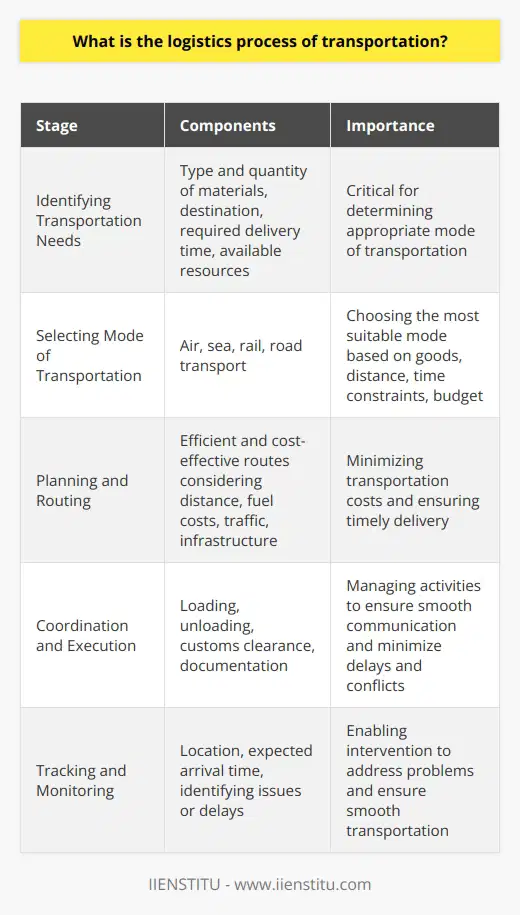
What is the system approach to logistics?
System Approach Explained
The system approach to logistics is a comprehensive methodology that considers all elements of a logistics system as interrelated and interdependent components. This approach emphasizes the need to understand the entire supply chain process, analyze the interactions between its parts, and optimize the system to achieve the organization's objectives.
Importance of Holistic View
A key aspect of the system approach is adopting a holistic view, which means that decision-makers must examine and evaluate the entire logistics process, rather than focusing solely on individual operations or activities. By considering the relationships and interdependencies among various functions, this approach creates opportunities for streamlining processes, enhancing efficiency, and reducing costs across the supply chain.
Integration and Coordination
An essential element of the system approach to logistics is the integration and coordination of various functions within the supply chain. This involves close collaboration and communication among departments, such as procurement, production, inventory management, transportation, and distribution. By fostering integration and coordination, the system approach ensures that all components work together in harmony and contribute to the overall efficiency and effectiveness of the logistics process.
Optimization Techniques
The implementation of the system approach to logistics often involves the use of optimization techniques, such as linear programming, simulation, and heuristic methods, to identify the best solutions for complex problems. These tools enable decision-makers to evaluate numerous alternatives, identify the most cost-effective and efficient solutions, and make informed decisions that align with the organization's objectives and constraints.
Continuous Improvement
A critical principle of the system approach to logistics is the commitment to continuous improvement. This means that organizations must consistently monitor, assess, and adjust their logistics processes to stay competitive and maintain high performance levels. By embracing the system approach, organizations can identify opportunities for improvement, implement changes, and measure the impact of their adjustments to ensure ongoing advancement in the logistics domain.
In conclusion, the system approach to logistics is a comprehensive and holistic methodology that focuses on the integration, coordination, optimization, and continuous improvement of various elements within the supply chain. By considering all aspects of the logistics process as interconnected and interdependent components, this approach enables organizations to enhance efficiency, reduce costs, and achieve their strategic objectives in a dynamic and competitive environment.
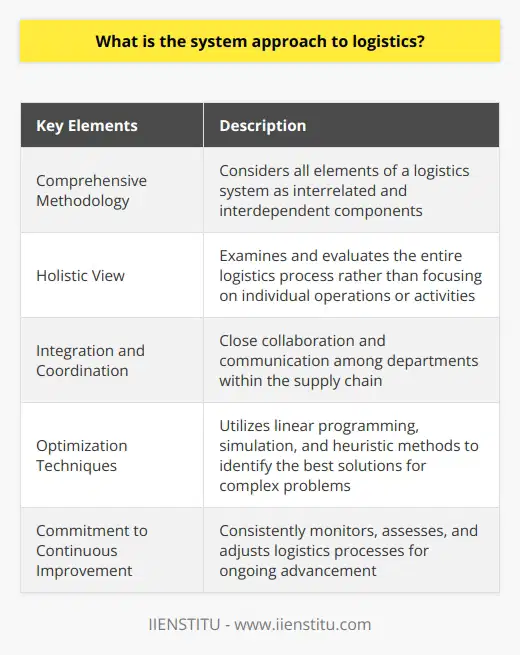
What are the 7 R approach of the modern understanding of logistics?
7 R Approach in Modern Logistics
Understanding the Concept
The seven R's of the modern understanding of logistics refer to the right product, right quantity, right condition, right place, right time, right customer, and right cost. This approach aims to guarantee efficient and effective logistical operations for organizations.
Right Product
Selecting the appropriate product is crucial for meeting customer demands. It entails having a proper inventory management system that tracks the availability of products, ensuring the business can fulfill orders and avoid stockouts or overstocking issues.
Right Quantity
Logistics should ensure the required volume of goods is available and transported as necessary. This requires strategic planning and coordination between different stages of the supply chain to avoid shortages or excess inventory.
Right Condition
Products must be delivered in the best possible condition to meet customer expectations. This means implementing appropriate packaging, handling, and transportation methods to maintain product quality during the entire logistics process.
Right Place
Efficiently delivering products to the correct location is vital in logistics. This involves well-planned routing, transportation networks, and distribution centers that enable timely and accurate delivery to the destination.
Right Time
Timely delivery is a critical element in meeting customer demands. Logistical operations need to be synchronized and well-coordinated to ensure goods reach their intended destination when needed, avoiding unnecessary delays or disruptions.
Right Customer
Targeting the appropriate customer base and ensuring they receive the intended products is crucial for achieving business objectives. This requires accurate data management, customer profiling, and proper order processing systems.
Right Cost
Optimizing the cost of logistics without compromising product quality, timely delivery, and customer satisfaction is necessary for businesses to remain competitive. Implementing cost-effective measures, resource optimization, and continuous improvement through innovation help achieve this goal.
In conclusion, the 7 R approach to modern logistics ensures organizations align their operations with customer requirements and market demands by utilizing best practices and efficient resource management. Embracing this approach leads to improved performance, customer satisfaction, and overall success in today's competitive business environment.
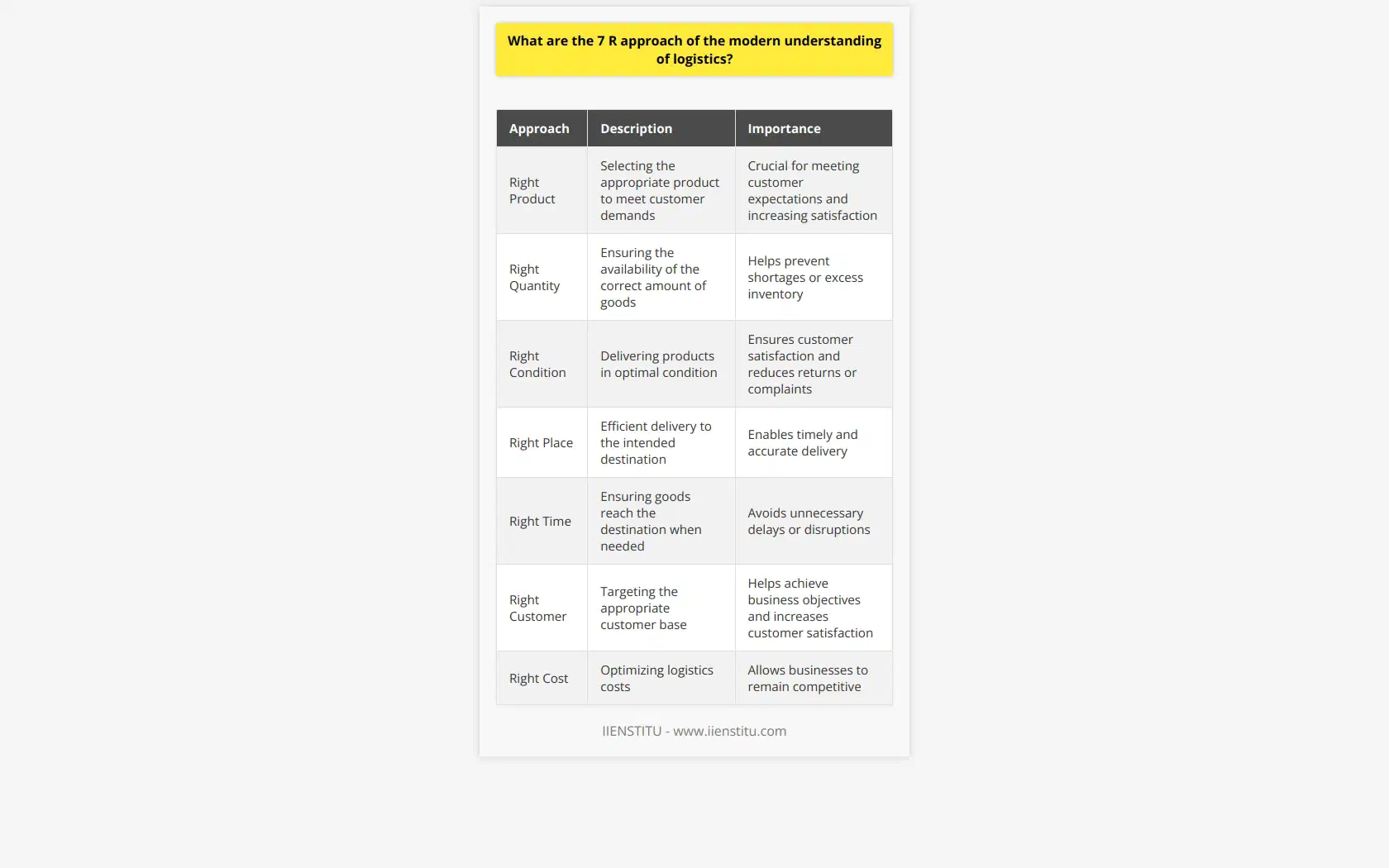
What is the role of technology in optimizing logistics systems?
Role of Technology in Enhancing Logistics Efficiency
An essential aspect of modern-day supply chains, technology plays a crucial role in optimizing logistics systems through various means. Particularly, technology helps improve operational efficiency, cost reduction, and excellent customer service.
Streamlining Processes and Operations
One critical role of technology in optimizing logistics systems is streamlining processes and operations. Technological advancements like automation and robotics have revolutionized the warehousing and distribution process, enabling quicker and more accurate picking and packing of goods. Consequently, this leads to a significant reduction in human errors and faster dispatch times for organizations.
Real-time Data and Advanced Analytics
Equipped with real-time data and advanced analytics, companies can now monitor and manage their entire supply chains more efficiently. Firms can track inventory levels, shipments, and other key performance indicators (KPIs) in real time, allowing them to make data-driven decisions and promptly address any potential issues. Similarly, advanced analytics deliver valuable insights to help organizations optimize planning, forecasting, and scheduling in their logistics systems.
Enhancing Supply Chain Visibility
Another role of technology in optimizing logistics systems is the enhancement of supply chain visibility. Modern logistics management software enables companies to have end-to-end visibility of their entire supply chain, from procurement to delivery. This visibility ensures organizations can better anticipate potential disruptions and can thus maintain a high level of customer satisfaction.
Optimizing Route Planning and Delivery
Moreover, technology significantly impacts route planning and delivery optimization. Innovations such as GPS tracking, geofencing, and route optimization algorithms enable logistics providers to maximize the efficiency of their fleets by selecting the most efficient transportation routes and minimizing fuel consumption. In turn, this reduces transportation costs and environmental impact.
Facilitating Collaboration and Connectivity
Lastly, technology promotes collaboration and connectivity among various supply chain partners by offering a digital platform for information exchange. Cloud-based logistics management systems allow stakeholders to share data and collaborate seamlessly, resulting in a more efficient and agile logistics network.
Overall, technology has become a vital component in optimizing logistics systems by streamlining operations, providing real-time data and analytics, enhancing supply chain visibility, optimizing route planning and delivery, and facilitating collaboration and connectivity among stakeholders. As a result, organizations can achieve significant operational efficiency, cost reduction, and ultimately, improved customer satisfaction.
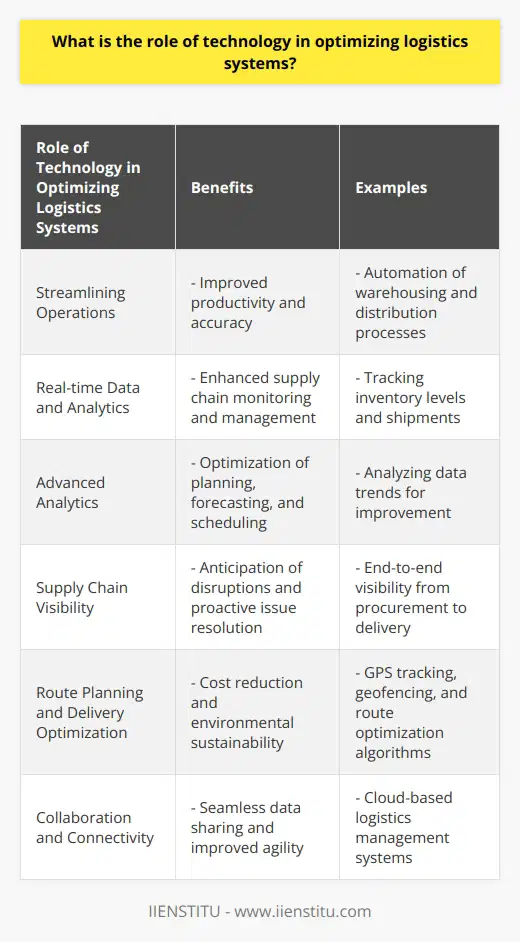
How do global trade regulations impact logistics processes?
Impact on Logistics Processes
Global trade regulations significantly impact logistics processes by determining the transportation, storage, and handling of goods across international borders.
Customs Compliance
One critical aspect of global trade regulations relates to customs compliance. These complex rules require businesses to provide accurate documentation, classifications, and valuations of the traded goods. Failure to adhere to customs regulations can result in delays, fines, and increased transportation costs, all of which can disrupt logistics processes and the overall supply chain.
International Standards
Global trade regulations include standards established by international organizations such as the World Trade Organization (WTO) and the International Chamber of Commerce (ICC). These rules aim to streamline global logistics processes through the standardization of shipment and contractual practices, which increases efficiency and reduces the risk of misunderstandings between trading partners.
Trade Agreements
Bilateral and multilateral trade agreements often dictate specific terms for the transportation of goods between signatory countries, impacting logistics processes. For instance, agreements may establish preferential tariff rates, trade quotas, or other measures influencing the import and export of goods. These factors directly affect logistics processes by dictating the volume of trade, the choice of transportation mode, and the routing of shipments.
Regulatory Bottlenecks
Trade regulations can also create bottlenecks in the logistics processes if they are overly cumbersome or inefficient. Examples of such inefficiencies include outdated customs procedures that require extensive manual documentation, or overly restrictive regulations concerning truck capacity or weight. Such bottlenecks disrupt global logistics processes by causing delays, reducing operational efficiency, and increasing overall transportation costs.
Sustainability and Ethics
Modern global trade regulations increasingly focus on sustainability and ethics in supply chain management. For example, businesses must provide extensive documentation to demonstrate that their products meet environmental standards or are free from forced labor. Such requirements influence logistics processes, as businesses must adapt their shipping procedures and choose suppliers and transporters that adhere to these rules.
In conclusion, global trade regulations play a vital role in shaping logistics processes by dictating customs compliance, applying international standards, establishing trade agreements, creating bottlenecks, and promoting sustainable and ethical business practices. To navigate these complexities, businesses must actively monitor and adapt to these evolving rules and regulations to ensure their logistics processes remain efficient and compliant.
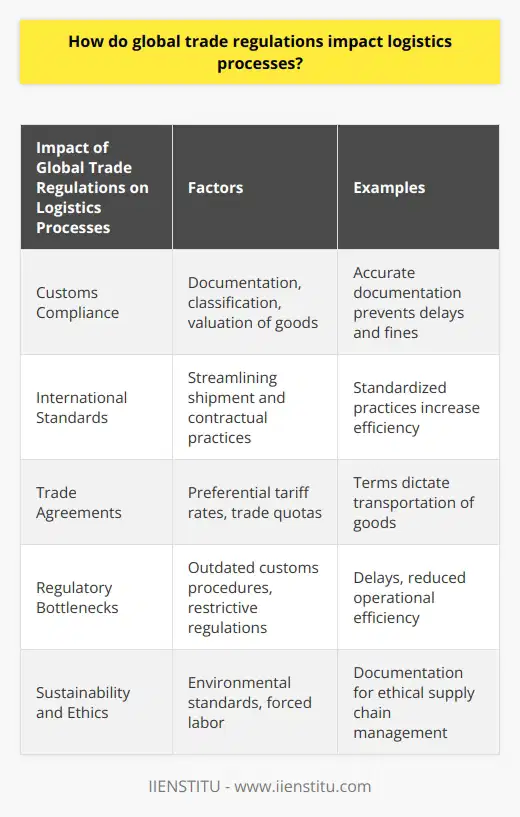
How can organizations achieve sustainable logistics and reduce environmental impact?
Incorporate Green Strategies
Organizations can achieve sustainable logistics and reduce environmental impact by incorporating green strategies into their supply chain processes. These strategies aim to minimize waste, reduce emissions, conserve resources, and promote recycling.
Adopt Efficient Transportation Models
One way to achieve sustainable logistics is through the adoption of efficient transportation models. For instance, organizations can encourage the use of environmentally friendly vehicles, such as electric and hybrid trucks. Furthermore, companies can optimize routing and load planning to reduce fuel consumption and emissions.
Implement Reverse Logistics
An effective method to reduce environmental impact is by implementing reverse logistics systems. This involves the collection, reuse, and recycling of waste materials generated during production and distribution processes. Organizations can collaborate with waste management companies to efficiently recover and repurpose resources, thereby minimizing landfill disposal.
Utilize Sustainable Packaging
Another critical aspect of sustainable logistics is the utilization of sustainable packaging materials and practices. Companies can use eco-friendly materials such as recyclable, reusable, and biodegradable packaging to lower their carbon footprint. Additionally, implementing lean packaging techniques and the use of multi-use pallets can help save natural resources and reduce waste.
Employ Energy-Efficient Technologies
To ensure more sustainable logistics operations, organizations can employ energy-efficient technologies in warehouses and distribution centers. This can include the installation of solar panels, energy-efficient lighting, and heating systems. Moreover, incorporating energy management software can help companies monitor and control energy consumption, leading to significant cost and energy savings.
Promote Environmental Awareness
Lastly, it is vital for organizations to promote environmental awareness among employees and stakeholders. This can involve offering training programs, workshops, and seminars on eco-friendly practices and incorporating sustainability performance metrics into financial evaluations. Creating an environmentally conscious organizational culture can go a long way in achieving sustainable logistics and reducing environmental impact.
In conclusion, companies can achieve sustainable logistics and minimize their environmental footprint by adopting green strategies, implementing efficient transportation and packaging practices, utilizing energy-efficient technologies, and fostering environmental awareness. By doing so, organizations not only protect the environment but also improve their performance, which can lead to increased profitability and competitive advantage.
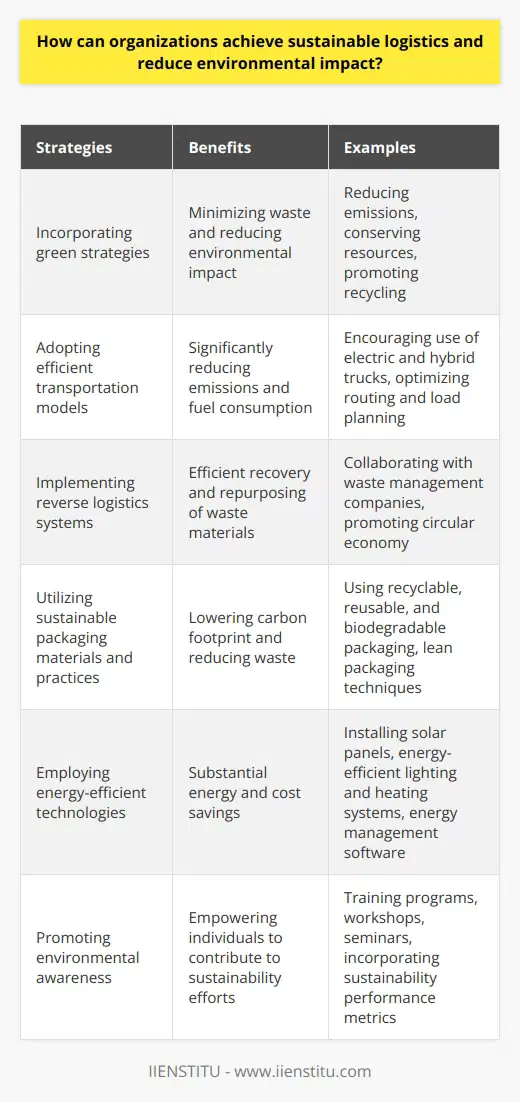
What are the key factors influencing the effectiveness of a logistics system?
Efficiency Factors in Logistics Systems
A logistics system's effectiveness is influenced by multiple factors, including network design, transportation, information technology, warehousing, and inventory management. An efficient logistics system is essential for meeting customer demands and minimizing costs, thus contributing to the overall success of an organization. This paragraph examines each key factor and its role in achieving an effective logistics system.
Network Design
A well-designed logistics network links suppliers, warehouses, and customers, streamlining inventory movement and reducing transportation expenses. Strategic selection of warehouse locations, optimal distribution routes, and effective load planning contribute to minimizing transit times and overall costs.
Transportation Management
Effective transportation management ensures the timely and cost-efficient movement of goods within the logistics system. Effective fleet management, route optimization, and carrier selection are critical to reducing transportation costs and ensuring on-time deliveries.
Information Technology
Utilizing advanced information technology in logistics operations facilitates real-time communication, data analysis, and visibility. Implementing electronic data interchange, global positioning systems, and warehouse management systems can significantly improve operational efficiency and customer service levels.
Warehouse Operations
Efficient warehouse operations involve optimizing storage space utilization, warehouse layout, and material handling processes. Implementing dynamic storage systems, employing advanced storage equipment, and integrating automated material handling technologies can significantly improve warehouse performance and reduce operating costs.
Inventory Management
Optimal inventory management lies at the heart of an effective logistics system, striking a balance between excess inventory costs and stockouts. Forecasting demand, implementing effective inventory policies, and using just-in-time inventory management techniques help maintain inventory levels that meet customer needs while minimizing carrying costs.
In conclusion, an effective logistics system is crucial to the overall success of an organization and depends on various factors, such as well-designed logistics networks, efficient transportation management, advanced information technology, optimized warehouse operations, and effective inventory management. By focusing on these key factors, organizations can enhance their logistics operations and meet customer demands in a timely and cost-effective manner.
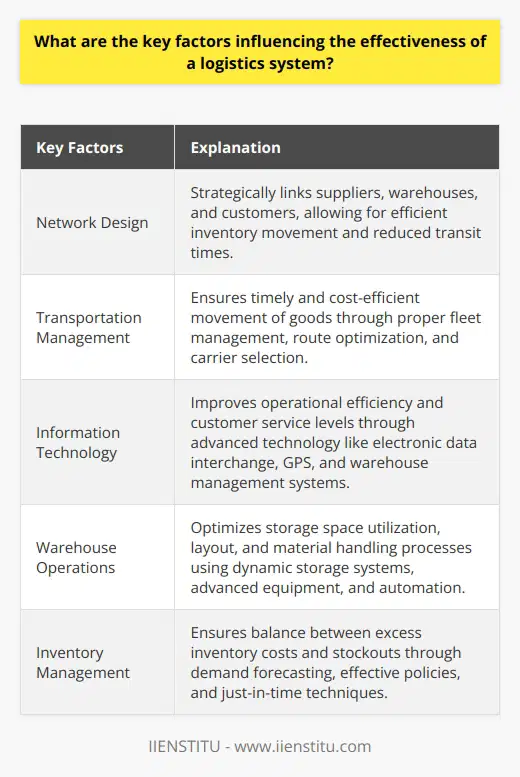
How do cultural differences impact the management and coordination of international logistics operations?
Cultural Impacts on Communication
Cultural differences significantly impact the management and coordination of international logistics operations. One considerable effect is the variation in communication styles, which can lead to misunderstandings, misinterpretations, and delayed responses. For instance, high-context cultures rely on nonverbal cues, while low-context cultures tend to be more explicit and direct in their communication. These divergent approaches can cause inefficiency and friction among logistics professionals from different cultural backgrounds.
Negotiation and Decision-Making
Moreover, cultural influences extend to negotiation and decision-making processes in international logistics management. Individuals from collectivist societies may prioritize maintaining harmonious relationships and reaching consensus over asserting individual opinions. Conversely, those from individualistic cultures might value assertiveness, autonomy, and competition. These distinctions can complicate decision-making and impede the swift resolution of conflicts or issues in logistics operations.
Time Perception and Priorities
Cultural variations in time perception and priorities also affect international logistics management. In monochronic cultures, time is viewed as linear, and punctuality is highly regarded. In contrast, polychronic cultures perceive time more flexibly and focus on the completion of tasks rather than strict adherence to schedules. Differences in time orientation can lead to misalignments in expectations, creating delays and inefficiencies in the logistics process.
Hierarchy and Power Distance
The organization of management and coordination in international logistics operations can be further influenced by cultural norms surrounding hierarchy and power distance. High power distance cultures accept and expect authority to be centralized and hierarchical, while low power distance cultures value decentralization and equality. This aspect can pose challenges in designing a management structure that accommodates diverse cultural expectations without sacrificing overall efficiency and effectiveness.
Adaptation and Collaboration Strategies
To minimize the potential negative impacts of cultural differences on international logistics management, it is essential to implement adaptation and collaboration strategies. Developing cultural competence, understanding cultural norms, and promoting open-mindedness can help logistics professionals navigate cultural differences more effectively. Additionally, employing effective communication tools and techniques, fostering cross-cultural teamwork, and establishing standard operating procedures can support increased coordination and collaboration across diverse cultures.
In conclusion, recognizing and addressing cultural differences in international logistics operations is crucial to ensure smooth and efficient management. By understanding and adapting to cultural variations in communication, negotiation, decision-making, time perception, and hierarchy, logistics professionals can overcome potential challenges and maximize the success of their global operations.
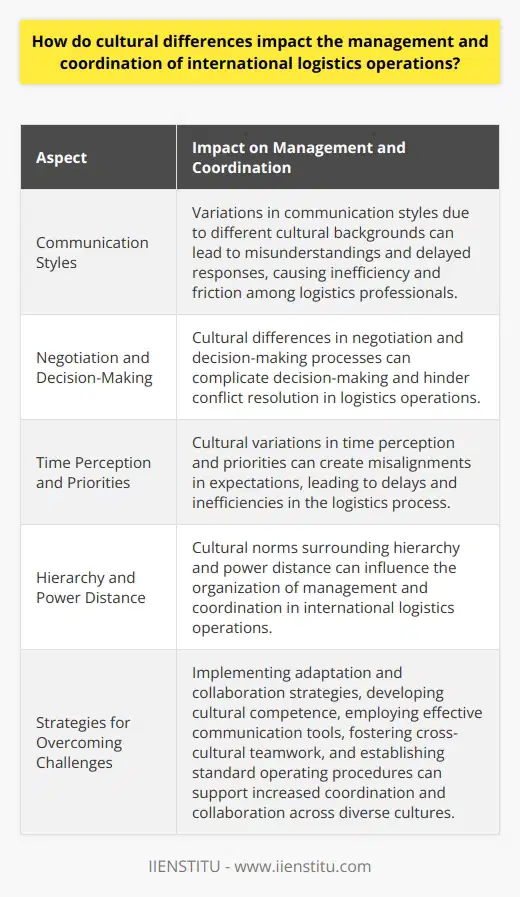
How does the integration of information technology and automation enhance the performance of logistics systems?
**Improved Efficiency**
The integration of information technology and automation in logistics systems significantly enhances their performance by boosting efficiency. Advanced technologies streamline processes, reduce manual labor, and facilitate real-time information exchange. Consequently, these factors lead to an increase in the accuracy and speed of operations.
**Enhanced Visibility**
Another critical advantage of technology integration in logistics systems is the enhanced visibility it offers to different parties involved. For instance, implementing advanced tracking systems and warehouse management software allows companies to have better control over their inventory. Additionally, this increased visibility enables businesses to make more informed decisions and optimize their supply chain performance.
**Increased Flexibility**
Information technology and automation provide logistics systems with increased flexibility, enabling them to adapt to changing market conditions effectively. Advanced technologies can help companies to manage their supply chain more efficiently, for example, by facilitating real-time adjustments to production schedules, transportation routes, and inventory levels. This capability enables businesses to meet fluctuating customer demands and stay competitive in the market.
**Reduced Costs**
Technology integration and automation in logistics systems also contribute to cost reduction. By automating manual tasks, companies can minimize labor costs and human error. Moreover, implementing advanced technologies helps to optimize the use of resources, such as vehicles and warehouse space, ultimately lowering operational expenses.
**Enhanced Customer Service**
Lastly, a well-integrated logistics system supported by information technology and automation can dramatically improve customer service. By providing real-time data, businesses can keep their customers informed about their order status and provide accurate delivery estimates. Additionally, technology-enabled logistics systems allow for more precise demand forecasting, ensuring that companies carry the right levels of inventory and can fulfill orders promptly.
In conclusion, the integration of information technology and automation enhances the performance of logistics systems by increasing efficiency, visibility, flexibility, and cost optimization while improving customer service. These improvements offer a competitive edge to businesses in today's dynamic market environment while ensuring a more streamlined and sustainable supply chain operation.

What is the relationship between supply chain management and logistics within a comprehensive system approach?
Mapping the Connection
Supply chain management and logistics interlink in a comprehensive system approach. The two concepts work together to optimize business functions. Supply chain management refers to the integrated planning, design, execution, control, and monitoring of supply activities. It encompasses every effort in product production and service delivery.
Role of Logistics in SCM
Logistics plays a vital part in supply chain management. It aligns the movement of goods, services, and information from the point of origin to consumption. Crucially, logistics ensures that these resources are available to the right destinations at the required time.
SCM, Logistics and Performance
The relationship between supply chain management and logistics significantly influences a company's performance. Efficient logistics build robust supply chains, thereby improving overall business performance. Both processes shape customer satisfaction, business profitability, and sustainability.
Barrier and Enabler
Inefficiencies in logistics could pose a barrier to effective supply chain management. On the brighter side, when logistics operations streamline, they enable seamless supply chain management. Thus, effective logistics serves as the backbone of successful and efficient supply chain management.
In summary, the relationship between supply chain management and logistics in a comprehensive system approach draws its strength from interdependence. While supply chain management organizes various business processes, logistics ensures the smooth transfer of goods, services, and information. Any lapse in logistics could break the supply chain, so efficient logistics are key to successful supply chain management.
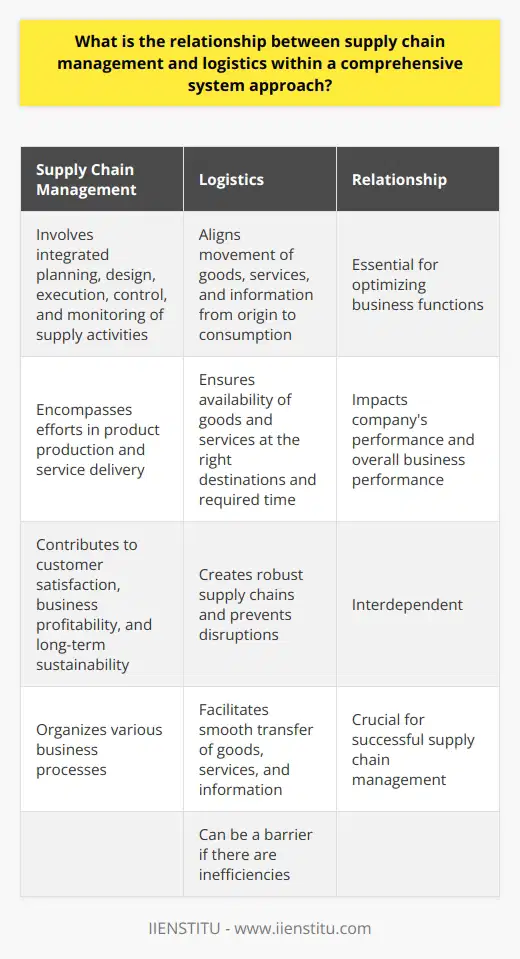
How do various external factors, such as economic conditions and geopolitical situations, affect the efficiency of logistics systems?
Impact of Economic Conditions
Economic conditions can significantly influence logistics system efficiency. During prosperous periods, buoyant demand often leads to increased production and shipments. However, when the economy dips, reduced demand translates to fewer logistic activities. Global economic instability can also affect the cost of key logistics components, such as fuel and labor.
Inflation Influence
Inflation bears a substantial impact on the efficiency of logistics systems. Raises in the price of goods and services typically lead to increased costs in transportation, warehousing, and handling of products. Moreover, logistics service providers may push rising costs to customers in the form of higher prices, causing a potential drop in demand.
Geopolitical Situations
Geopolitical situations play an important role too. Political stability in a logistics provider's operational regions ensures smooth operations. Conversely, political unrest can disrupt supply chains and impede the movement of goods, thereby reducing the efficiency of logistics systems.
Trade Policies and Regulations
Trade policies and regulations also considerably impact logistics efficiency. For instance, restrictive customs procedures may increase the dwell time of goods, causing delays. On the other hand, agreements such as Free Trade Agreements (FTAs) often facilitate faster clearance and delivery of goods.
Currency Fluctuations
Finally, fluctuations in currency values influence international logistics' efficiency. A weaker domestic currency results in comparatively higher import costs, thereby affecting logistics directly related to imports. Conversely, a stronger currency could lower import costs, streamlining logistics.
In conclusion, understanding these factors can help logistics providers plan ahead and implement measures that maintain efficiency, ultimately ensuring the smooth operation of supply chains regardless of external environments.
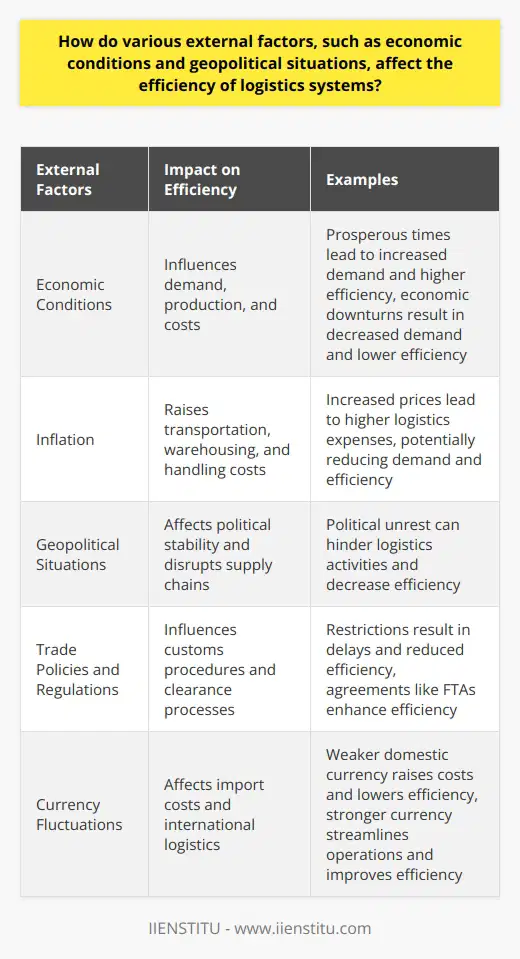
In the context of the 7 R approach, how can organizations minimize risks and uncertainties within their logistics operations?
Adopting the 7R Approach
The 7R approach signifies Right Product, Right Quantity, Right Condition, Right Place, Right Time, Right Customer and Right Cost. Organizations can utilize this approach to minimize logistics operations' risks and uncertainties.
Risk Minimization Techniques
By ensuring the right product is always in the supply chain, businesses mitigate the risk of product misplacement or obsolescence. It also guarantees that customers consistently receive the correct items, which fosters trust and strengthens the customer-supplier relationship.
Importance of Right Quantity and Condition
Maintaining the right quantity in stock reduces the risk of overstock or stockout situations. Similarly, ensuring the right condition of products eliminates the risk of damage during storage or transportation. Both these aspects play a vital role in maintaining customer satisfaction and retention.
Concentration on Place and Time
Getting products to the right place at the right time is central to fulfilling customer expectations. It helps in reducing the risks associated with late deliveries, thereby improving customer service and satisfaction.
Customer-Cost Relationship
Delivering the right product to the right customer ensures targeted and efficient logistics operations. Equally important is providing these services at the right cost. Balancing cost and quality lowers the risk of financial losses and enhances profitability.
In conclusion, the 7R approach provides a robust framework for organizations to minimize risks and uncertainties within logistics operations. By focusing on these seven critical aspects, businesses can optimize their operations, satisfy customer expectations, and ultimately achieve better profitability.
